| Alopekis (Αλωπεκίς) | |||||||||||||||||||||
|---|---|---|---|---|---|---|---|---|---|---|---|---|---|---|---|---|---|---|---|---|---|
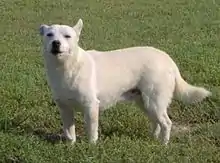 White Alopekis | |||||||||||||||||||||
| Origin | Greece | ||||||||||||||||||||
| Breed status | Not recognised as a breed by any major kennel club. | ||||||||||||||||||||
| |||||||||||||||||||||
| Dog (domestic dog) | |||||||||||||||||||||
The Alopekis (Greek: Αλωπεκίς) is a small to medium sized, ancient, primitive landrace of dog from Greece and adjacent regions of the Balkan peninsula. Alopekis have prick ears, a curved tail, and a double coat.[1] Alopekis were bred as a multipurpose farm dog, functioning as a hunting dog, watchdog and shepherd.[2] The dog is found throughout Greece but is most commonly seen in northern Greek regions with a lot of farmland and villages, such as Serres, Drama, Xanthi, etc.[3] Critically endangered, there are around 50 known examples of the breed remaining today.[2][4]
This breed is not recognized by the Fédération Cynologique Internationale.[5] The natural and artificial selection of the dog breed with the Kokoni breed has led to only a few hundred Alopekis still existing. Mixed breeds of Kokoni are commonly mischaracterized as Alopekis.
Etymology
The Ancient Greek ἀλωπεκίς (alōpekís) means "small fox" or "fox-like".[4] Ancient sources also describe them as "Κυναλώπηξ" (Kunalṓpēx), which means fox-dog.[4] The dog has many additional names including Alepuditsa, Alepudoskylo, Ventaki, Zacharoskylo, Moropa, Bombis or Bouboudi, Tsoupi or Tsupaki, and Ilia.[2][4]
History
The domestication of the Alopekis dog in Greece dates before the Mycenaean era., i.e. 1750 B.C.[6] The earliest depiction comes from the post-Paleolithic / Neolithic era (3000 BC Neolithic Greece). It is an engraved pithos from Thessaly that bears a scribble with the characteristic silhouette of an Alopekis and is in the archaeological museum of Athens. This finding places the tribe in the same historical period and geographical area as the Pelasgians. This is the oldest depiction of a dog in Greece. A similar find was also found in Rafina and dates from the Early Bronze Age (2500–2100 BC).[7][6][8]
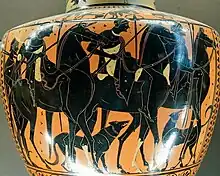
Ancient Greek classical authors mention the breed, including Aristotle, Xenophon and Aristophanes. Xenophon describes the Alopekis as one of the two main Greek examples of hunting dogs in his work Cynegeticus.[9] Ancient authors including Xenophon believed that Aopekis were created by mating dogs and foxes.[9][10]
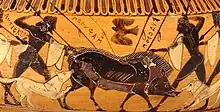
The Alopekis has experienced a massive reduction in population, in part because of the mass sterilization of dogs in some regions to reduce the number of strays. There are still small populations in Northern Greece.[3] Greek native groups are now working to preserve the breed.[3]
Description
Appearance
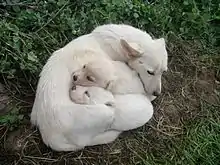
Alopekis are small to medium sized, fox-like, relatively short-haired with wedge-shaped head, erect ears and sickle-shaped tail.[11] Their body is longer than their height.[11] Alopekis are classified as primitive dogs: they have regular dentition and a mesomorphic, symmetrical build and body type, with an arched or semicircular tail. Typical individuals do not show dwarfism. Their bodies are robust and their limbs are not markedly shortened (and acquired clubfoot is an undesirable feature). Breed proportions indicate a model of progressive downsizing through evolution, adaptation, and artificial selection usually with the Kokoni breed.[12]
Alopekis average 40–65 centimetres (16–26 in) high at the withers and weigh an average of 14–25 kilograms (31–55 lb).[6] The breed has three types of double coat: a) a short, hard and smooth coat, b) semi-long, tufted, rough coat and c) semi-long, hard, wiry coat.[11] The coat is usually never thin, sparse, soft and silky, nor is the protective-insulating undercoat be missing, because this is a robust small-medium sizzed breed of general utility that should be able to live outdoors without a problem. The coat is easy to groom and the texture and quality of the coat helps keep it clean. [11] Alopekis are very clean by nature and clean themselves frequently and diligently. The breed does not seem to attract parasites as much as other dog breeds. All colors and color combinations are acceptable, except for the absence of pigment (albino). The most common colors are white, black, brown and bicolor (black and white, white with black or brown patches, black with white markings, brown with fiery markings) and less often whitish, pale yellow and other colors.[11]
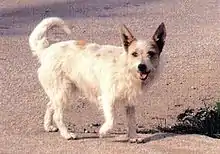
Temperament
As a companion, Alopekis are very obedient, quiet and loyal to their owners.[11] Alopekis are usually very expressive and friendly towards people, however they are alert dogs that are protective of other farm animals and good with children.[11] Alopekis are also good hunters, especially against pests like rats.[2][11] Alopekis are high energy dogs capable of covering very long distances.[11][2] They are versatile dogs suitable for either an urban or rural and adapt readily as a companion for all ages of people.[11][6][2]
Usage
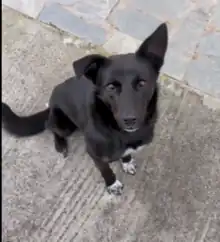
Alopekis populations existed throughout Greece until recently and one of their traditional uses was the extermination of rodents such as rats and mice, as well as the protection of domestic poultry from foxes, jackals and ferrets.[2] With their small-medium size, Alopekis comfortably nest together with hens and ducks in the backyard chicken coop and also work well with the larger sheepdogs on the farm. The breed is an excellent watchdog, showing bravery and strength when needed.[11]
See also
References
- ↑ Studdert, Virginia P.; Gay, Clive C. (2011). Saunders Comprehensive Veterinary Dictionary E-Book. Elsevier Health Sciences. p. 37. ISBN 978-0-7020-4744-2. Archived from the original on 2023-09-14. Retrieved 2023-03-13.
- 1 2 3 4 5 6 7 "Κινδυνεύει με εξαφάνιση ο αρχαιοελληνικός σκύλος "Αλωπεκίς"" [The ancient Greek dog "Alopekis" is in danger of extinction]. News.gr (in Greek). 2013-02-08. Archived from the original on 2018-03-28. Retrieved 2023-09-10.
- 1 2 3 "Αρχαιοελληνική ράτσα σκύλου «ζει και κινδυνεύει»" [Ancient Greek dog breed "lives and is in danger"]. To Vima (in Greek). Athens. 13 February 2013. Archived from the original on 2 August 2021. Retrieved 22 May 2020.
- 1 2 3 4 "Alopekis Dog Breed". Native Breed.org. 2020-12-29. Archived from the original on 2021-02-02. Retrieved 2023-09-11.
- ↑ "Fédération Cynologique Internationale". www.fci.be. Retrieved 2023-09-20.
- 1 2 3 4 Новости, Р. И. А. (2013-02-11). "Древнейшая в Греции порода собак алопекис вымирает" [The oldest dog breed in Greece, the Alopekis, is becoming extinct.]. РИА Новости (in Russian). Archived from the original on 2023-09-14. Retrieved 2023-09-10.
- ↑ "Εθνικό Αρχαιολογικό Μουσείο, Νεολιθικές Αρχαιότητες" [National Archaeological Museum, Neolithic Antiquities]. National Archeological Museum (in Greek). Archived from the original on 2017-02-11. Retrieved 2013-05-11.
- ↑ "Αρχαιοελληνική ράτσα σκύλου «ζει και κινδυνεύει»" [Ancient Greek breed of dog "alive and endangered"]. ΤΟ ΒΗΜΑ (in Greek). 2013-02-08. Archived from the original on 2022-01-21. Retrieved 2023-09-11.
- 1 2 Xenophon. CYNEGETICUS [THE SPORTSMAN ON HUNTING] (in Ancient Greek). Translated by Dakyns, H.G. Archived from the original on 2021-06-10. Retrieved 2023-09-12.
- ↑ Aristotle. Aristotle's History of Animals (in Ancient Greek). Translated by Cresswell, Richard. Archived from the original on 2023-01-07. Retrieved 2023-09-12.
- 1 2 3 4 5 6 7 8 9 10 11 "Πρότυπο Φυλής Αλωπεκίς" [Alopekis Breed Standard]. Dogpark.gr (in Greek). 2020-07-22. Archived from the original on 2022-02-08. Retrieved 2023-09-11.
- ↑ Sutter, Nathan B.; Bustamante, Carlos D.; Chase, Kevin; Gray, Melissa M.; Zhao, Keyan; Zhu, Lan; Padhukasahasram, Badri; Karlins, Eric; Davis, Sean; Jones, Paul G.; Quignon, Pascale; Johnson, Gary S.; Parker, Heidi G.; Fretwell, Neale; Mosher, Dana S. (2007-04-06). "A Single IGF1 Allele Is a Major Determinant of Small Size in Dogs". Science. 316 (5821): 112–115. Bibcode:2007Sci...316..112S. doi:10.1126/science.1137045. ISSN 0036-8075. PMC 2789551. PMID 17412960.
External links
Greece’s New Pet Law May Threaten Ancient Greek Dog Breed Alopekis